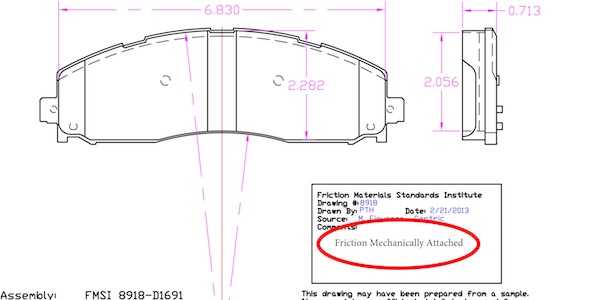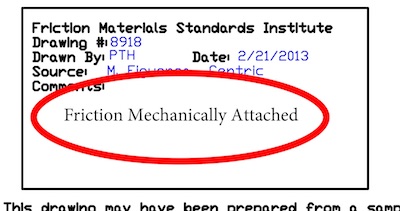The Friction Materials Standards Institute (FMSI) has updated its database to include information on whether the original brake pads from the OEMs utilize mechanical attachment methods to secure the friction material to the backing plate.
FMSI has identified 42 D-numbers (brake pad part numbers) that come from the OEMs with mechanical attachment. The part numbers and associated applications represent about 30 percent of the cars, trucks and school buses on the roads in North America.

“FMSI is in year two of an aggressive five-year plan upgrading and modernizing our operating systems,” said Frank Oliveto, president of FMSI. “Ahead of our plan, we are heavily investing in new systems and technologies to enhance and expand information, protecting our intellectual property and improving the user experience for our members.”
The members of the Global Brake Safety Council (GBSC) are encouraged that this very vital information is finally being shared with North American aftermarket brake pad manufacturers and suppliers that utilize the FMSI numbering system.

Mechanical attachment for brake pads should be treated very seriously as it is very similar to rebar in concrete, according to the GBSC. Just like rebar-reinforced concrete, you cannot see the mechanical attachment in a brake pad.
Mechanical attachment is required on specific applications for high loads where adhesive alone would lead to pad failure in OEM testing. This recognition by FMSI and industry-wide awareness will help improve the safety and quality of aftermarket brake pads across North America.
According to a recent technical bulletin from the GBSC, mechanical attachment is specified by OEMs to meet performance and safety requirements for a vehicle platform. The replacement brake pad needs to duplicate the mechanical attachment feature for these applications by aftermarket pad manufacturers. Removing the mechanical attachment feature will compromise the structural integrity of the entire brake system.
GBSC also encourages anyone in the supply chain of selling to North American aftermarket brake pads to join FMSI. Go to www.fmsi.org to gain access to their numbering system and this critical information.
About FMSI
Friction Materials Standards Institute‘s (FMSI) mission is to collect, characterize, and communicate to FMSI’s members the vehicle manufacturer’s OE service product and include this product information in the FMSI and FMS standardized part numbering system. Established in 1948, FMSI was founded as a trade association of automotive aftermarket friction manufacturers with the goal of creating a standardized part numbering system for brakes and clutch facings. From manufacturer through shops one part number is used as the standard and as a common language – the FMSI number.
Membership in FMSI is open to any manufacturer of friction and related products covered by the trademarked FMSI and FMS part numbers. Other participants in this industry may be eligible for licensee membership.
About the GBSC
Global Brake Safety Council (GBSC) is established with the intent to uphold the highest standards in brake safety and dedicated to responsible manufacturing in the automotive industry. Utilizing over 300 years of combined industry experience, this group of technical experts is composed of: professional engineers, OE design engineers and product development and R&D professionals. This team is committed to raising awareness of issues that are critical to public safety through education.
Members of this council are recipients of the Automotive News PACE Award in the Manufacturing Process Category for providing a compelling example of an innovative solution to an unsatisfactory but accepted process in the automotive industry.
Article courtesy Brake & Front End.














